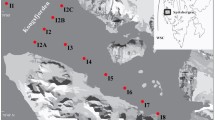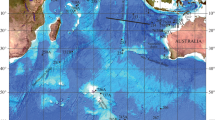Abstract
Rivers draining into the Gulf of Papua (GOP) from the Papua New Guinea mainland deliver approximately 340 × 106 t yr−1 of sediment to the marine environment. The terrestrially derived sediment contains 1.1 ± 0.2% particulate organic carbon with a carbon-isotope composition of −26.5 ± 0.2‰, and amounts to 3.7 ± 0.7 × 106 t yr−1. The carbon-isotope composition of sediments in the Gulf of Papua indicates that 40% of the sediment cover contains 75% or more terrestrially derived carbon. Suspended sediments that are transported beyond the delta complex of the Fly River are transported north and northwest, augmented by sediments from other rivers along the coast of the GOP. The carbon-isotope results suggest that a significant quantity of terrestrially derived sediment escapes from the GOP, either along the coastlines to east and west or into the deep ocean via the Moresby and Pandora troughs. Little sediment travels south onto the Great Barrier Reef shelf. Extrapolating the results from this study to the region of Oceania suggests a total flux of particulate organic carbon to the world's oceans from the islands of Oceania of ~ 90 × 106 t yr−1 or twice the flux of riverine POC from the major rivers of North America, South America, and Africa combined. While such a calculation must be considered illustrative only, the similar tectonic, geomorphologic, and climatic features of the islands of Oceania suggest that the calculation is unlikely to be grossly in error and that the rivers of Oceania therefore represent a major but poorly documented source of sediment and organic carbon to the global ocean.
Similar content being viewed by others
References
Alongi DM, Christofferson P, Tirendi F, and Robertson AI (1992) The influence of freshwater and material export on sedimentary facies and benthic processes within the Fly delta and adjcent Gulf of Papua (Papua New Guinea). Continental Shelf Research 12:287–326
Berner RA (1982) Burial of organic carbon and pyrite sulphur in the modern ocean: Its geochemical and environmental significance. American Journal of Science 282:451–473
Berner RA (1992) Comments on the role of marine sediment burial as a repository for anthropogenic CO2. Global Biogeochemical Cycles 6:1–2
Bird MI, Fyfe WS, Pinheiro-Dick D, and Chivas AR (1992) Carbonisotope indicators of catchment vegetation in the Brazilian Amazon. Global Biogeochemical Cycles 6:293–306
Bird MI, Haberle S, and Chivas AR (1994) The effect of altitude on the carbon-isotope composition of forest and grassland soils from Papua New Guinea. Global Biogeochemical Cycles 8:13–22
Brookfield HC and Hart D (1966) Rainfall in the tropical southwest Pacific. Department of Geography Publication G/3, Australian National University, Canberra
Brunskill G, Murray A, Zagorskis I, and Tirendi F (1993) Fly River delta sedimentation and organic matter storage. Abstracts: Influence of Tropical Rivers on Coastal Oceanographic Processes. 21–26 June, Cape Ferguson, Queensland, Australian Institute of Marine Science. p 25
Brunskill GJ, Woolfe KJ, and Zagorskis I (1995) Distribution of riverine sediment chemistry on the shelf, slope and rise of the Gulf of Papua. Geo-Marine Letters 15:160–165
Burrage D, Hughes R, and Bode L (1993) Circulation of the Northern Coral Sea and Gulf of Papua. Abstracts: Influence of Tropical Rivers on Coastal Oceanographic Processes. 21–26 June, Cape Ferguson, Queensland, Australian Institute of Marine Science. p 8
Cai D-L, Tan FC, and Edmond JM (1988) Sources and transport of particulate organic carbon in the Amazon River and Estuary. Estuarine, Coastal and Shelf Science 26:1–14
Degens ET, Kempe S, and Richey JE (1991) Summary: Biogeochemistry of major world rivers. In: Degens ET, Kempe S, and Richey JE (Eds.), Biogeochemistry of Major World Rivers. SCOPE report 42. Chichester: John Wiley & Sons. pp 323–347
Eagle AM, Markam AJ, Wood IB, and Dietrich W (1993) The origin and fate of sediment yields in the Fly River catchment, Papua New Guinea. Abstracts: Influence of Tropical Rivers on Coastal Oceanographic Processes. 21–26 June, Cape Ferguson, Queensland, Australian Institute of Marine Science. p 36
Emerson S and Hedges JI (1988) Processes controlling the organic carbon content of open ocean sediments. Paleoceanography 5:621–634
Fontugne M and Duplessy JC (1978) Carbon isotope ratio of marine plankton related to surface water masses. Earth and Planetary Science Letters 41:365–371
Gagan MK, Sandstrom MW, and Chivas AR (1987) Restricted terrestrial carbon input to the continental shelf during Cyclone Winnifred: Implications for terrestrial runoff to the Great Barrier Reef Province. Coral Reefs 6:113–119
Gagan MK, Chivas AR, and Herczeg AL (1990) Shelf-wide erosion deposition and suspended sediment transport during Cyclone Winnifred, Central Great Barrier Reef, Australia. Journal of Sedimentary Petrology 60:456–470
Gearing P, Plucker FE, and Parker PL (1977) Organic carbon stable isotope ratios of continental margin sediments. Marine Chemistry 5:251–266
Harris PT, Baker EK, Cole AR, and Short SA (1993) A preliminary study of sedimentation in the tidally dominated Fly River Delta, Gulf of Papua. Continental Shelf Research 13:441–472
Hedges JI, Clark WA, Quay PD, Richey JE, Devol AH, and Santos U de M (1986) Compositions and fluxes of particulate organic material in the Amazon River. Limnology and Oceanography 31:717–738
Loffler E (1974) Explanatory notes to the geomorphological map of Papua New Guinea. CSIRO Australian Land Resources Series 33. 75 pp
Loffler E (1977) Geomorphology of Papua New Guinea. Canberra: Australian National University Press. 315 pp
MacFarlane JW (1980) Surface and bottom sea currents in the Gulf of Papua and western Coral Sea P.N.G. Department of Primary Industry Research Bulletin 27:128 pp
Marriotti A, Gadel F, Giresse P, and Kinga-Mouzeo (1991) Carbon isotope composition and geochemistry of particulate organic matter in the Congo River (central Africa): Application to the study of Quaternary sediments off the mouth of the river. Chemical Geology (Isotope Geoscience Section) 86:345–357
McAlpine JR, Keig G, and Falls R (1983) Climate of Papua New Guinea. Canberra: Australian National University Press. 315 pp
Milliman JD and Syvitski JPM (1992) Geomorphic/tectonic control of sediment discharge to the ocean: The importance of small rivers. Journal of Geology 100:525–544
Paijmans K (1983) Vegetation of the Purari catchment. In: Petr T (Ed.), The Purari—Tropical Environment of a High Rainfall River Basin. Amsterdam: Junk. pp 227–252
Petr T (Ed.) (1983) The Purari—Tropical Environment of a High Rainfall River Basin. Amsterdam: Junk. 355 pp
Rau GH, Sweeney RE, and Kaplan IR (1982) Plankton13C:12C ratio changes with latitude: Differences between northern and southern oceans. Deep Sea Research 8A:1035–1039
Robertson A (1993) The role of mangroves in the flux of carbon from the Fly River to the Gulf of Papua. Abstracts: Influence of Tropical Rivers on Coastal Oceanographic Processes. 21–26 June, Cape Ferguson, Queensland, Australian Institute of Marine Science. p 31
Rodelli MR, Gearing JN, Gearing JP, Marshall N, and Sasekumar A (1984) Stable isotope ratio as a tracer of mangrove carbon in Malaysian ecosystems. Oecologia 61:326–333
Salomons W and Eagle AM (1990) Hydrology, sedimentology and the fate and distribution of copper in mine-related discharges in the Fly River system, Papua New Guinea. Science of the Total Environment 97/98:315–334
Schlesinger WH and Melack JM (1981) Transport of organic carbon in the world's rivers. Tellus 33:172–187
Showers WJ and Angle DG (1986) Stable isotopic characterization of organic carbon accumulation on the Amazon continental shelf. Continental Shelf Research 6:227–244
Sofer Z (1980) Preparation of carbon dioxide for stable carbonisotope analysis of petroleum fractions. Analytical Chemistry 52:1389–1391
Torgersen T and Chivas AR (1985) Terrestrial organic carbon in marine sediment: A preliminary balance for a mangrove environment derived from13C. Chemical Geology (Isotope Geoscience Section) 52:379–390
Torgersen T, Chivas AR, and Chapman A (1983) Chemical and isotopic characterisation and sedimentation rates in Princess Charlotte Bay, Queensland. Bureau of Mineral Resources. Journal of Geology and Geophysics 8:191–200
Wolanski EJ and Eagle AM (1991) Oceanography and sediment transport, Fly River Estuary and Gulf of Papua. Proceedings 10th Australasian Conference Coastal Ocean Engineering, Auckland, New Zealand 2–6 December 1991
Wolanski EJ, Pickard GL, and Jupp DLB (1984) River plumes, coral reefs and mixing in the Gulf of Papua and northern Great Barrier Reef. Estuarine, Coastal and Shelf Science 18:291–314
Author information
Authors and Affiliations
Rights and permissions
About this article
Cite this article
Bird, M.I., Chivas, A.R. & Brunskill, G.J. Carbon-isotope composition of sediments from the Gulf of Papua. Geo-Marine Letters 15, 153–159 (1995). https://doi.org/10.1007/BF01204457
Received:
Issue Date:
DOI: https://doi.org/10.1007/BF01204457




